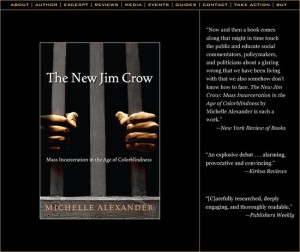
I just finished reading The New Jim Crow: Mass Incarceration in the Age of Colorblindness by Michelle Alexander, with a forward by Cornel West (The New Press, 2012). I urge people to read this essential book.
Alexander’s thesis is that just as Jim Crow replaced slavery as the mechanism for keeping former slaves “in their place” after the white Southern elite reestablished control following the end of the Reconstruction period, mass incarceration, fueled by the war on drugs, serves the same function today. Alexander charts the rebirth of the caste system in the South after the emancipation of the slaves. This system was based upon both the terror of the KKK, and the prosecution of vagrancy statutes and anything that might be interpreted as “uppity” as criminal offenses, that provided the white ruling class with a steady flow of convict labor. Thus, the old slave system was replaced by a new system that gave nominal freedom to African Americans while subjugating them as a permanent sub-caste.
Given the cultural depth and political efficacy of racism (it enabled rich whites to pit poor whites against blacks), it is hardly surprising that a transformed but virulent incarnation of it became prevalent in the late 19th century. Alexander argues very effectively that this happened again in the wake of the Civil Rights Movement’s success in undermining much of the original Jim Crow system in the 1960’s. The code phrases “law and order,” and “get tough on crime” signaled a white backlash against the gains of the Civil Rights movement as the 1970’s progressed and reached a fever pitch after the election of Ronald Reagan and during the crack cocaine panic of the 1980’s. Anti-drug laws were passed that imposed draconian sentences, the Supreme Court issued a series of rulings that enabled police to stop and search virtually anyone, and this new power was applied selectively to urban young people of color even though their rate of drug use was no higher than that of suburban white youth.
Tens of thousands of people snared by the dragnet for minor drug infractions were induced to accept plea deals that, while offering shorter prison sentences, branded them felons. Alexander points out that the “system depends on the prison label, not the prison time (p. 94).” Congress and the States have passed a series of laws that legalize discrimination against convicted felons in jobs, housing, and public services, and deny them many citizenship rights. Thus, just as with the old Jim Crow, a significant percentage of African American men are ineligible to vote, not because of a poll tax or literacy requirement, but because they have been convicted of a felony.
The explosion of the U.S. prison population (now over 2,000,000) is dwarfed by the number of those who have been released but remain under the supervision of the penal system. Moreover, former prisoners who manage to stay out long enough to complete their probation carry the label of “convicted felon” for life. This has shredded the social fabric of poor urban neighborhoods of people of color and created a permanent under-caste of despised non-persons.
I doubt much of this information is new to the RFC community, especially those familiar with the fine work to expose the prison industrial complex done by the Critical Resistance movement led by Angela Davis. And, of course, I can’t help but oversimplify Alexanders’ book with just a few hundred words to summarize it.
Yet, I was most impressed with the excellent job this book does of presenting the evidence in a manner that is designed to convince those who are not already persuaded. Perhaps this effect is because Alexander has only recently come to this understanding. She received elite liberal training (graduated Stanford Law School, clerked for Justice Harry A. Blackmun on the Supreme Court, and later directed the Racial Justice Project for the ACLU in Northern California). Ten years ago she believed that the criminal justice system was one more institution affected by racism. Now she has come to realize that: “mass incarceration … ha[s] in fact, emerged as a stunningly comprehensive and well-disguised system of racialized social control that functions in a manner strikingly similar to Jim Crow (p. 4).”
Mass imprisonment and the War on Drugs are scourges that must be stopped before we can become a more just and equitable nation. This book is a valuable tool we can use to move in that direction.
-------------------------
To receive a notification whenever there is a new post to Out on a Limb Together, subscribe now.
